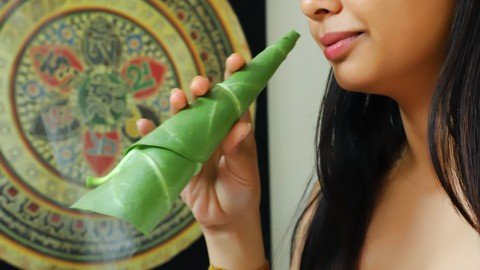V
Video789
Guest
Offline

Last updated 12/2020
MP4 | Video: h264, 1280x720 | Audio: AAC, 44.1 KHz
Language: English | Size: 3.24 GB | Duration: 3h 13m
ayurveda therapy and Panchakarma therapy
What you'll learn
Ayurveda Therapy in real PRACTICE
Ayurveda Therapies and Panchakarma therapies
Requirements
Basics of Ayurveda
Description
Students are learning very practical aspect of Ayurvedic Therapies.learning Marma points of Headlearning Pinda swedan for pain at homelearning Indian Head Massage at homelearning Nasyam therapy for sinuses learning Janu Basti for Knee joint painlearn udawatana power exfoliation massage learn Shirodhara body and mind therapyback pain Kati Basti therapyBasti, enema colon clean detox therapy treat emotion with Heart BastiKnee joint Pain therapyMukh lepam for face beautyAyurveda emphasizes preventative and healing therapies along with various methods of purification and rejuvenation. Ayurveda is more than a mere healing system; it is a science and an art of appropriate living that helps to achieve longevity. It can guide every individual in the proper choice of diet, living habits and exercise to restore balance in the body, mind and consciousness, thus preventing disease from gaining a foothold in the system.According to Ayurveda, every human being is a unique phenomenon of cosmic consciousness, manifested through the five basic elements-Ether, Air, Fire, Water and Earth. Vata-a combination of ether and air, pitta-a combination of fire and water, and kapha-a combination of water and earth, are called the tridosha. These are the three humors or the three organizations of the body, which are also derived from consciousness. Each individual constitution or psycho-somatic temperament is determined by the relative proportions of these three doshas at the time of fertilization. When the embryo is formed, the constitution is determined. There are seven basic constitutions with one or more doshas predominant according to Ayurveda. They are: vata, pitta or kapha predominant, vata-pitta, pitta- kapha or kapha-vata predominant and vata-pitta-kapha in equal balance, a rare occurrence.Every individual constitution has its own unique balance of vata, pitta and kapha (VPK) according to its own nature. This balance of VPK is the natural order. When this doshic balance is disturbed, it creates imbalance, which is disorder. Health is order; disease is disorder. Within the body there is a constant interaction between order and disorder, thus once one understands the nature and structure of disorder, one can re-establish order. Ayurveda believes that order lies within disorder.Order is the state of health, as defined by Ayurveda. This exists when the digestive fire (agni) is in a balanced condition; the bodily humors (vata, pitta and kapha) are in equilibrium, the three waste products (urine, feces and sweat) are produced and eliminated normally, the seven bodily tissues (rasa, rakta, mamsa, meda, asthi, majja and shukra/artava) are functioning normally, and the mind, senses and consciousness are working harmoniously together. When the balance of these systems is disturbed, the disease (disorder) process begins.The internal environment is governed by vata, pitta and kapha, which are constantly reacting to the external environment. The wrong diet, habits, lifestyle, incompatible food combinations (e.g., milk and fish, melons and grain, yogurt and meat or eating cooked honey, etc.), seasonal changes, repressed emotions and stress factors can all act either together or separately to change the balance of vata, pitta and kapha. According to the nature of the cause, vata, pitta or kapha undergo aggravation or derangement, which affects the agni (gastric fire) and produces ama (toxins).This ama enters the blood stream and is circulated throughout the body, clogging the channels. Retention of toxins in the blood results in toxemia. This accumulated toxicity, once well established, will slowly affect prana (vital life energy), ojas (immunity), and tejas (cellular metabolic energy), resulting in disease. This can be nature's effort to eliminate toxicity from the body. Every so-called disease is a crisis of ama toxicity. Ama is the basic internal cause of all disease, due to the aggravated doshas.Herein lies the key to the prevention of disease: help the body eliminate the toxins. To stop the further production of ama, Ayurvedic literature suggests putting the person on a proper diet with appropriate lifestyle, habits and exercise, and administering a proper cleansing program such as panchakarma. (Although panchakarma is often thought of as the entire procedure, it really is only one part of a group of therapies belonging to a class of cleansing procedures called shodana. There is also a group of milder techniques called shamana for those not strong enough for shodana.)
Overview
Section 1: Ayurvedic Therapies1
Lecture 1 5 Amazing Marma points of Head
Lecture 2 Treat Pain with Ayurveda
Lecture 3 Indian Head Massages/ Shiroabhayanga part 1
Lecture 4 Head Massage/ Shiroabhayanga part 2
Lecture 5 Nasyam - clean sinuses and have smooth breath
Lecture 6 Nasyam practical part -1
Lecture 7 POTALI MASSAGE DETAILS
Section 2: Ayurvedic Therapies 2
Lecture 8 kati Basti - for back pain
Lecture 9 Hridaya Basti - balance emotions and anxeity
Lecture 10 Janu Basti - Oil therapy for Knee
Lecture 11 Mukha Lepam - Ayurvedic uplifting face with facial
Lecture 12 Udawartana - treat cellulitis and fat under skin
Lecture 13 Detox colon (Basti) - Clean colon at Home
Lecture 14 Nasyam: clean sinus and have smooth breathing !!!
Ayurveda Practitioner, Spa therapist,Yoga therapist, Healers, Natural therapist, health professional, chiropractor,herbalist, homeopath, Naturopath, pharmacist,
Homepage
Code:
https://www.udemy.com/course/ayurveda-therapy-course/
Fikper



Links are Interchangeable - No Password - Single Extraction